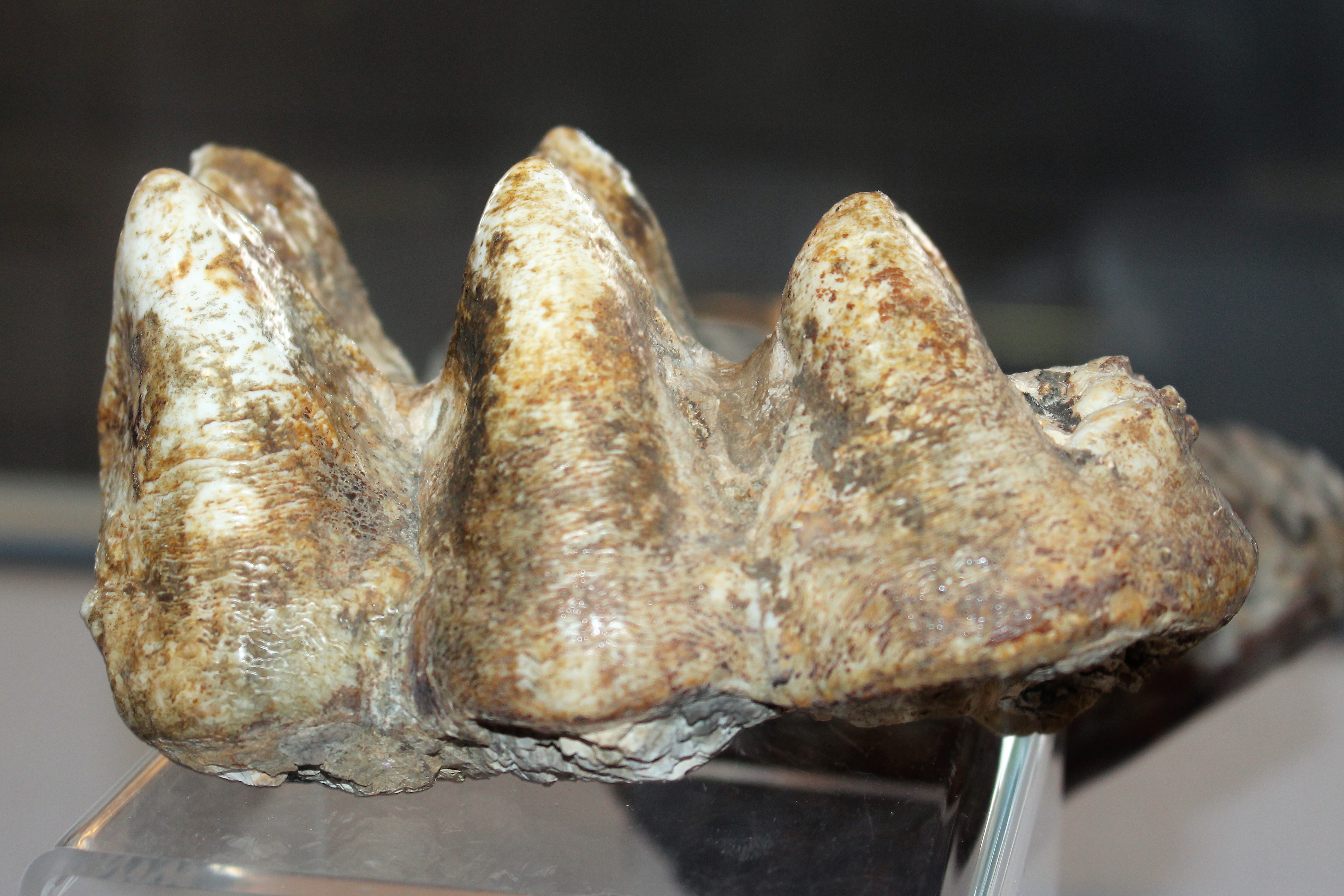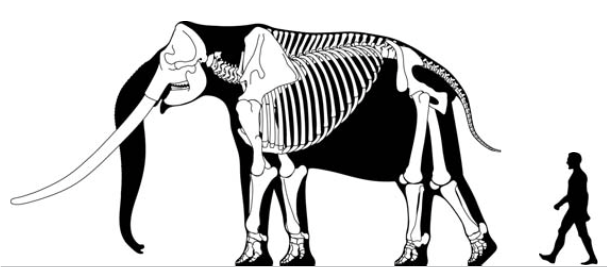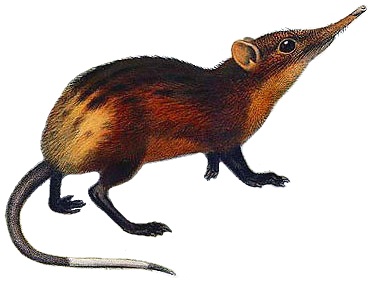|
Proboscideans
Proboscidea (; , ) is a taxonomic order of afrotherian mammals containing one living family (Elephantidae) and several extinct families. First described by J. Illiger in 1811, it encompasses the elephants and their close relatives. Three living species of elephant are currently recognised: the African bush elephant, the African forest elephant, and the Asian elephant. Extinct members of Proboscidea include the deinotheres, mastodons, gomphotheres and stegodonts. The family Elephantidae also contains several extinct groups, including mammoths and ''Palaeoloxodon''. Proboscideans include some of the largest known land mammals, with the elephant '' Palaeoloxodon namadicus'' and mastodon ''"Mammut" borsoni'' suggested to have body masses surpassing , rivalling or exceeding paraceratheres (the otherwise largest known land mammals) in size. The largest extant proboscidean is the African bush elephant, with a world record of size of at the shoulder and . In addition to their enor ... [...More Info...] [...Related Items...] OR: [Wikipedia] [Google] [Baidu] |
Mastodon
A mastodon, from Ancient Greek μαστός (''mastós''), meaning "breast", and ὀδούς (''odoús'') "tooth", is a member of the genus ''Mammut'' (German for 'mammoth'), which was endemic to North America and lived from the late Miocene to the early Holocene. Mastodons belong to the order Proboscidea, the same order as elephants and mammoths (which belong to the family Elephantidae). ''Mammut'' is the type genus of the extinct family Mammutidae, which diverged from the ancestors of modern elephants at least 27–25 million years ago, during the Oligocene. Like other members of Mammutidae, the molar (tooth), molar teeth of mastodons have zygodont morphology (where parallel pairs of cusp (anatomy), cusps are merged into sharp ridges), which strongly differ from those of elephantids. In comparison to its likely ancestor ''Zygolophodon'', ''Mammut'' is characterized by particularly long and upward curving upper tusks, reduced or absent tusks on the lower jaw, as well a ... [...More Info...] [...Related Items...] OR: [Wikipedia] [Google] [Baidu] |
Stegodon
''Stegodon'' (from the Ancient Greek στέγω (''stégō''), meaning "to cover", and ὀδούς (''odoús''), meaning "tooth", named for the distinctive ridges on the animal's molars) is an extinct genus of proboscidean, related to elephants. It was originally assigned to the family Elephantidae along with modern elephants but is now placed in the extinct family Stegodontidae. Like elephants, ''Stegodon'' had teeth with plate-like lophs that are different from those of more primitive proboscideans like gomphotheres and mammutids. Fossils of the genus are known from Africa and across much of Asia, as far southeast as Timor (with a single record in southeast Europe). The oldest fossils of the genus are found in Late Miocene strata in Asia, likely originating from the more archaic ''Stegolophodon,'' subsequently migrating into Africa. While the genus became extinct in Africa during the Pliocene, ''Stegodon'' persisted in South, Southeast and Eastern Asia into the Late Pleisto ... [...More Info...] [...Related Items...] OR: [Wikipedia] [Google] [Baidu] |
Moeritherium
''Moeritherium'' ("the beast from Lake Moeris") is an extinct genus of basal proboscideans from the Eocene of North and West Africa. The first specimen was discovered in strata from the Fayum fossil deposits of Egypt. It was named in 1901 by Charles William Andrews, who suggested that it was an early proboscidean, perhaps ancestral to mastodons, although subsequent workers considered it everything from a relative of manatees to a close relative of both clades' common ancestor. Currently, ''Moeritherium'' is seen as a proboscidean that, while fairly basal, predates the split between elephantiforms and deinotheres. Seven species have been named, though only three (''M. lyonsi'', ''M. gracile'', and ''M. chehbeurameuri''), are currently considered valid. ''Moeritherium'' is unusual even among basal proboscidean standards. Like many later members of the group, it had two sets of tusks: the ones on the upper jaw pointed downwards, while those of the mandible (lower jaw) were fla ... [...More Info...] [...Related Items...] OR: [Wikipedia] [Google] [Baidu] |
Gomphothere
Gomphotheres are an extinct group of proboscideans related to modern elephants. First appearing in Africa during the Oligocene, they dispersed into Eurasia and North America during the Miocene and arrived in South America during the Pleistocene as part of the Great American Interchange. Gomphotheres are a paraphyletic group ancestral to Elephantidae, which contains modern elephants, as well as Stegodontidae. While most famous forms such as '' Gomphotherium'' had long lower jaws with tusks, the ancestral condition for the group, some later members developed shortened (brevirostrine) lower jaws with either vestigial or no lower tusks and outlasted the long-jawed gomphotheres. This change made them look very similar to modern elephants, an example of parallel evolution. During the Pliocene and Early Pleistocene, the diversity of gomphotheres declined, ultimately becoming extinct outside of the Americas. The last two genera, '' Cuvieronius'' ranging southern North America to weste ... [...More Info...] [...Related Items...] OR: [Wikipedia] [Google] [Baidu] |
Elephant
Elephants are the largest living land animals. Three living species are currently recognised: the African bush elephant ('' Loxodonta africana''), the African forest elephant (''L. cyclotis''), and the Asian elephant ('' Elephas maximus''). They are the only surviving members of the family Elephantidae and the order Proboscidea; extinct relatives include mammoths and mastodons. Distinctive features of elephants include a long proboscis called a trunk, tusks, large ear flaps, pillar-like legs, and tough but sensitive grey skin. The trunk is prehensile, bringing food and water to the mouth and grasping objects. Tusks, which are derived from the incisor teeth, serve both as weapons and as tools for moving objects and digging. The large ear flaps assist in maintaining a constant body temperature as well as in communication. African elephants have larger ears and concave backs, whereas Asian elephants have smaller ears and convex or level backs. Elephants are scatter ... [...More Info...] [...Related Items...] OR: [Wikipedia] [Google] [Baidu] |
Numidotherium , has been reassigned to its own genus, '' Arcanotherium''.''Numidotherium'' (meaning "Numidia beast" in Ancient Greek) is an extinct genus of early proboscideans, discovered in 1984, that lived during the middle Eocene of North Africa some 46 million years ago. It was about tall at the shoulder and weighed about . The type species, ''N. koholense'', is known from an almost complete skeleton from the site of El Kohol, southern Algeria, dating from the early/middle Eocene period. The animal had the size and the appearance of a modern tapir. In appearance, it was more slender and more plantigrade than an elephant, its closest modern relative.Libya [...More Info...] [...Related Items...] OR: [Wikipedia] [Google] [Baidu] |
Mammoth
A mammoth is any species of the extinct elephantid genus ''Mammuthus.'' They lived from the late Miocene epoch (from around 6.2 million years ago) into the Holocene until about 4,000 years ago, with mammoth species at various times inhabiting Africa, Asia, Europe, and North America. Mammoths are distinguished from living elephants by their (typically large) spirally twisted tusks and in some later species, the development of numerous adaptions to living in cold environments, including a thick layer of fur. Mammoths and Asian elephants are more closely related to each other than they are to African elephants. The oldest mammoth representative, '' Mammuthus subplanifrons'', appeared around 6 million years ago during the late Miocene in what is now southern and Eastern Africa.'''' Later in the Pliocene, by about three million years ago, mammoths dispersed into Eurasia, eventually covering most of Eurasia before migrating into North America around 1.5–1.3 million year ... [...More Info...] [...Related Items...] OR: [Wikipedia] [Google] [Baidu] |
Phosphatherium
''Phosphatherium escuilliei'', named by Gheerbrant, Sudre and Cappetta in 1996, is a basal proboscidean that lived in Africa during the early Eocene, about 56-55 Ma. It is one of the earliest known proboscideans, together with ''Eritherium azzouzorum'' from the Selandian (about 60 Ma). It was found in phosphorites beds from the base of the Ypresian stage of the Ouled Abdoun Basin, which is best known for its exceptionally rich marine vertebrate fauna. Description The species ''P. escuilliei'' is known from relatively well-preserved fossils, including several sub-complete skulls that have enabled the reconstruction of the animal's head. The skull of ''Phosphatherium'' is very primitive compared to advanced proboscideans (Elephantiformes), for example the nasal openings are anterior, indicating that it lacked a trunk. Other plesiomorphic traits are the elongated face, the narrow rostrum, the strong sagittal and nuchal crests, the presence of an alisphenoid canal, the auditory ... [...More Info...] [...Related Items...] OR: [Wikipedia] [Google] [Baidu] |
Elephantidae
Elephantidae is a family (biology), family of large, herbivorous proboscidean mammals which includes the living Elephant, elephants (belonging to the genera ''Elephas'' and ''Loxodonta''), as well as a number of extinct genera like ''Mammuthus'' (mammoths) and ''Palaeoloxodon''. They are large terrestrial animal, terrestrial mammals with a snout modified into a Elephant#Trunk, trunk and teeth modified into tusks. Most Genus, genera and species in the family are extinction, extinct. The family was first described by John Edward Gray in 1821, and later assigned to taxonomic ranks within the order Proboscidea. Elephantidae has been revised by various authors to include or exclude other extinct proboscidean genera. Description Elephantids are distinguished from more basal proboscideans like gomphotheres by their teeth, which have parallel lophs, formed from the merger of the cusps found in the teeth of more basal proboscideans, which are bound by cementum. In later elephantids, t ... [...More Info...] [...Related Items...] OR: [Wikipedia] [Google] [Baidu] |
Daouitherium
''Daouitherium'' ("Sidi Daoui beast" from the name of the site where it was discovered) is an extinct genus of early proboscideans (a group including modern elephants and their extinct relatives) that lived during the early Eocene (Ypresian stage) some 55 million years ago in North Africa. Remains of this animal, fragments of jaws and teeth, have been found in the Ouled Abdoun Basin in Morocco. It is estimated to have weighed between , making it one of the earliest large mammals known from Africa and one of the oldest known proboscideans. Another estimate gives a weight of . Description ''Daouitherium'' is known only from lower jaws and associated cheek teeth. It had lophodont and bilophodont molars, i.e. molars with large ridges. The second and third premolars had a notably large cusp called the hypoconid. Gheerbrant et al. described the teeth as similar to those of other early proboscideans '' Phosphatherium'', '' Numidotherium'', and '' Barytherium''. Taxonomy A cl ... [...More Info...] [...Related Items...] OR: [Wikipedia] [Google] [Baidu] |
Barytherium
''Barytherium'' (meaning "heavy beast") is a genus of an extinct genus of large primitive proboscideans that lived during the late Eocene and early Oligocene in North Africa. The type species is ''Barytherium grave'', found at the beginning of the 20th century in Fayum, Egypt. Since then, more complete specimens have been found at Dor el Talha, Libya. More fossils were also discovered in 2011 in the Aidum area in Dhofar by Oman's Ministry of Heritage and Culture, which was named ''Barytherium omansi''. Description The barytheriids were the first large proboscideans to appear in the fossil records. ''Barytherium'' itself stood about 1.8–2.0 m tall at the shoulder and weighed around 2 tonnes. ''Barytherium'' spp. had eight very short tusks, four each in the upper and lower jaws, which resembled those of a modern hippopotamus more than those of an elephant. The upper pairs were vertical, while the lower pairs projected forwards from the mouth horizontally. Together, these woul ... [...More Info...] [...Related Items...] OR: [Wikipedia] [Google] [Baidu] |
Eritherium
''Eritherium'' is an extinct genus of early Proboscidea found in the Ouled Abdoun basin (early Thanetian age), Morocco. It lived about 60 million years ago. It was first named by Emmanuel Gheerbrant in 2009 and the type species is ''Eritherium azzouzorum''. ''Eritherium ''is the oldest, smallest and most primitive known elephant relative. Description The holotype (specimen number MNHN PM69) is now in the Musée d'histoire naturelle - Guimet in Lyon and includes an upper jaw (with approaches of the zygomatic bone and two maxillary branches, each of the two posterior premolars (P3 and 4) and three molars (M1-3)). The piece is about 6 inches long, 5 inches wide and just over 3 inches high. In addition, the fossils include 15 more objects including the skull bones (frontal and nasal bones), lower jaw fragments and teeth and the upper and lower jaw. It was about 20 cm tall at the shoulder and weighed about 5–6 kg. Generally, ''Eritherium ''shared similarities in the ... [...More Info...] [...Related Items...] OR: [Wikipedia] [Google] [Baidu] |







